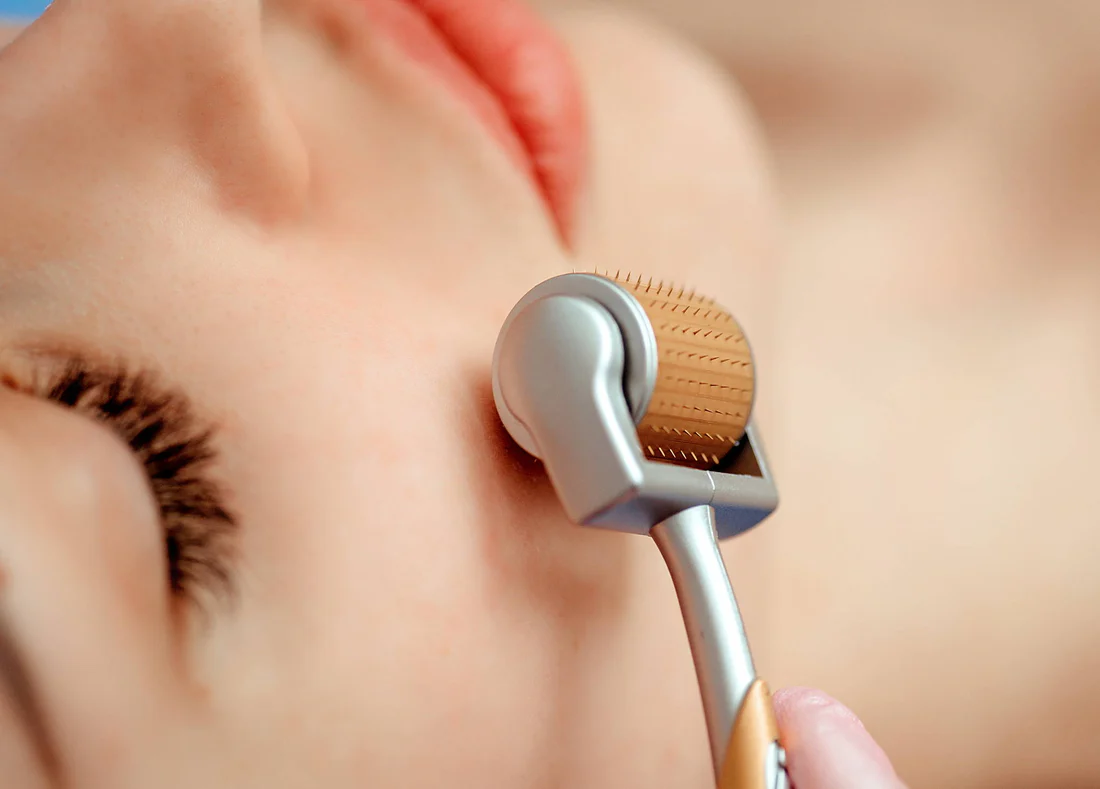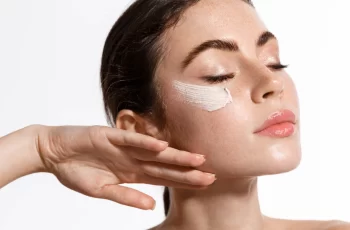The idea of microneedling may seem intimidating, but it’s actually an effective skincare treatment with numerous benefits. Its primary advantage lies in promoting the skin’s natural healing process, which visibly reduces fine lines and wrinkles. Additionally, it addresses issues like uneven texture caused by acne scars or other skin conditions.
If you’re curious about how microneedling works and its benefits, let’s break it down.
How Does Microneedling Work?
Microneedling involves using a small, pen-like device equipped with tiny needles. These needles create micro-tears in the skin, triggering the production of collagen and elastin as the skin believes it’s been injured. This process results in the growth of new skin cells, giving you a brighter, plumper, and more youthful complexion.
Collagen: Found in the deeper layers of the skin, collagen supports skin structure and maintains its youthful appearance. However, as we age, collagen production slows, leading to visible signs like fine lines, wrinkles, and a weakened skin barrier.
Elastin: Known as the skin’s protein, elastin keeps the skin firm and flexible. A decline in elastin makes the skin sag, contributing to an aged appearance.
Microneedling is commonly offered at professional salons and spas and should always be performed in a sterile environment by a trained expert. While at-home devices are available, they require thorough research and careful use to avoid skin damage. If your budget allows, seeking professional treatment is the safer option.
Post-Microneedling Care
Aftercare is crucial for optimal results from microneedling. Certain ingredients should be avoided entirely, while others can be reintroduced at the right time. Today, we’ll explore whether it’s safe to use vitamin C after microneedling and the best practices for post-treatment care.
Is Vitamin C Safe After Microneedling?
Yes and no. You should only use vitamin C immediately after microneedling if advised by your dermatologist. Vitamin C’s antioxidant properties can aid in healing and maintaining skin health. However, it’s generally best to avoid potent actives like vitamin C, glycolic acid, salicylic acid, and retinol immediately after microneedling.
Microneedling creates tiny tears in the skin, leaving it more vulnerable to irritation and adverse reactions. Always consult the professional performing your treatment to determine if vitamin C is suitable for your post-care routine.
What Serum Should You Use After Microneedling?
Hyaluronic acid serums are the top choice after microneedling. With its moisture-binding properties and ability to hydrate multiple skin layers, hyaluronic acid promotes healing and soothes the skin. Microneedling also enhances the serum’s absorption, maximizing its hydrating effects.
If your skin feels tight after the treatment, applying a generous layer of hyaluronic acid serum will provide immediate comfort and leave your skin glowing.
Should You Use Moisturizer After Microneedling?
Definitely! Moisturizers help restore the skin’s lipid barrier and lock in hydration. Look for formulas enriched with ingredients like hyaluronic acid, vitamin E, and other nourishing actives. Avoid moisturizers containing fragrances or harsh additives that may irritate the skin.
What to Avoid After Microneedling
Exfoliating Ingredients: Retinol, AHAs (like glycolic acid), and BHAs (like salicylic acid) should be avoided until your skin heals. These can cause dryness, redness, and irritation.
Direct Sun Exposure: Apply SPF regularly for at least two weeks post-treatment to protect your skin from harmful UV rays and environmental damage.
Touching Your Face: Minimize contact with your hands to prevent bacterial infections.
Makeup: Refrain from using makeup and makeup brushes for the first 24 hours.
Swimming, Saunas, and Exercise: Avoid activities that cause excessive sweating for at least 72 hours.
Summary
After microneedling, focus on hydration and protection by using products like hyaluronic acid and moisturizers. Avoid active ingredients that can irritate your skin during the healing process. Following these guidelines will ensure your skin recovers effectively, leaving it radiant and healthy.
For more tips and answers to your questions, feel free to connect with us on Instagram!
DQH Can I use salicylic acid first and then vitamin C?
It’s easy to create a skincare routine, but knowing how to use it is another thing entirely. In most cases, if you’re not getting the desired skin results, it could be due to the layering of conflicting ingredients. So, is it possible that salicylic acid and vitamin C are such ingredients? Or are these active ingredients the duo that’s been missing from your skincare routine? If you want answers, stick around because today we are going to explain the benefits of salicylic acid and vitamin C and how they can be used in your daily life.
What are the benefits of salicylic acid for skin?
Salicylic acid is one of the most commonly used beta hydroxy acids and is favored by many people with oily, acne-prone skin. This acid is derived from willow bark, and unlike its water-soluble relatives (called alpha-hydroxy acids), salicylic acid is oil-soluble, which means it can penetrate deeper into the lower layers of the skin. Once it reaches the lower layers, it can help unclog pores of excess sebum, dirt, bacteria, debris, and impurities. This results in clearer skin tones and greater definition.
Not only does salicylic acid benefit the underlying layers, but the outer surface of the skin benefits as well. When applied to the skin, salicylic acid removes the buildup of dead skin cells. This is accomplished by breaking the bonds that hold dead cells to the surface. Over time, this can cause the complexion to look dull and prone to acne, blackheads, and other blemishes.
If you’d like to learn more about salicylic acid and how it can improve your skin, check out this dedicated blog post from a beauty insider.
What are the benefits of vitamin C for skin?
Vitamin C is considered one of the most powerful antioxidants, which means it is very effective at fighting free radicals and preventing them from causing further skin damage. Examples of free radicals include pollution, central heating, UV rays and harsh climate. They attack proteins, fats and cell membranes as soon as they come into contact with the skin, causing signs of premature aging such as fine lines and wrinkles as well as hyperpigmentation, flaky patches of skin and loss of elasticity.
Many people usually prefer to use vitamin C in their morning routine as this ingredient gives the complexion a radiant glow. You’ll also find that vitamin C can target areas of hyperpigmentation, plumping the skin and reducing the appearance of fine lines and wrinkles.
The thing about vitamin C is that there are a lot of outdated studies going back to the 1950s that describe vitamin C as an unstable skin component. Thanks to improvements in modern technology, this is no longer the case as all products now contain a stable form of vitamin C.
Visit The Beauty Insider to learn more about vitamin C. So please check out our blog post.
Can I use salicylic acid first and then vitamin C?
Yes, you absolutely can. In fact, it’s thought that using salicylic acid before using vitamin C ensures it penetrates faster and works faster.
This is an efficient way to utilize two power sources, and the reason has to do with pH. For example, the skin’s natural pH is about 4.7, making it slightly acidic. Salicylic acid and vitamin C are also both acidic, and you’ll find that vitamin C is absorbed quickly into the skin. Therefore, using salicylic acid beforehand can increase the acidity of the skin and allow vitamin C to penetrate into the skin faster.
While this is considered an effective way to combine two powerful ingredients, you need to be aware of your skin type and how it reacts to certain active ingredients. Even people with perfect, normal skin can experience skin sensitivity and irritation. Therefore, always consult a doctor or dermatologist before using any new products on your skin.
It’s also important to follow skin application rules. In this case, you need to use the product correctly to ensure you get the best results for your skin. If you’re not sure what I mean, the basic rule for skin is to start with the thinnest consistency and work your way up to the thickest consistency. This prevents a barrier from forming on the surface, preventing other active ingredients from penetrating the skin.
Can I use salicylic acid at night and vitamin C in the morning?
Yes, absolutely, this is considered the most effective way to get returns without any adverse side effects. This is because there is enough time between applications to ensure that the skin’s pH levels return to balance.
You’ll also find that Vitamin C is rich in antioxidants and is perfect for use in the morning to ensure your skin is protected and looking its healthiest. Due to the small size of salicylic acid molecules, it is an acid that is able to reach the deepest parts of the skin. While this is effective at keeping skin clear, it also increases the risk of irritation and photosensitivity. Therefore, many people prefer to use powerful BHAs in their evening routine without exposure to UV rays, pollution, or harsh weather.
Warning: If you avoid using sunscreen every day, none of these ingredients will do what your skin needs. The combination of chemical peels and powerful ingredients increases the risk of further damage to the skin’s surface. Use SPF 50 every day to keep your skin protected and your lipid barrier healthy, even on cloudy days, keeping your skin in top condition.



